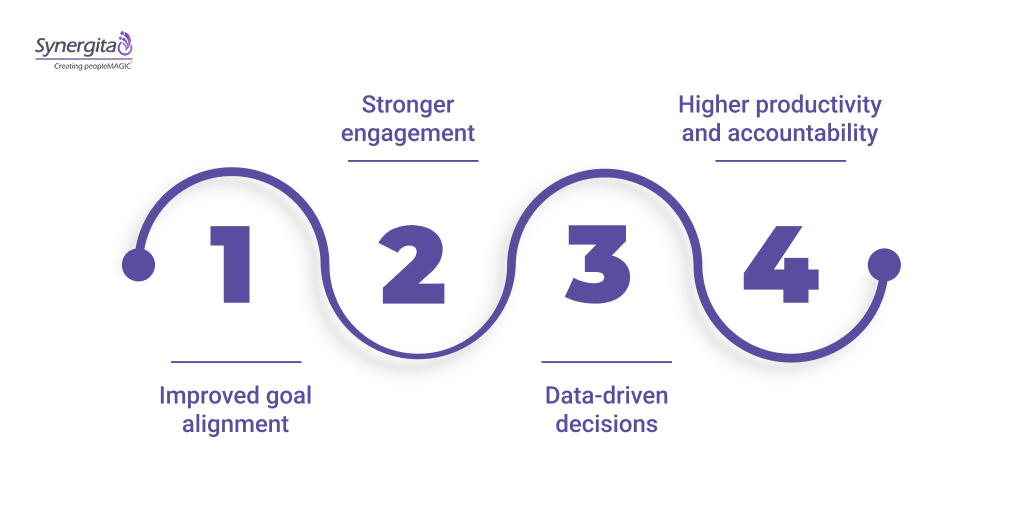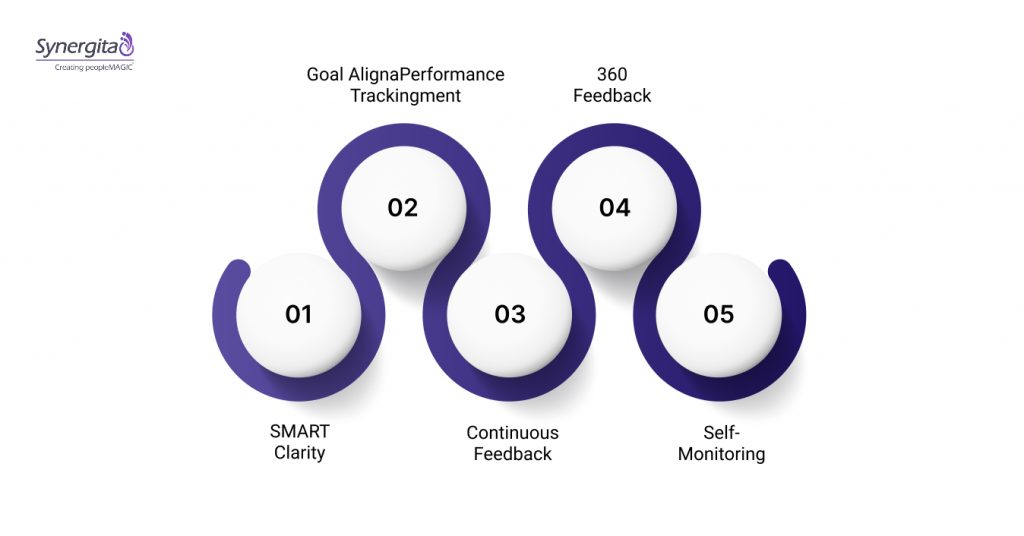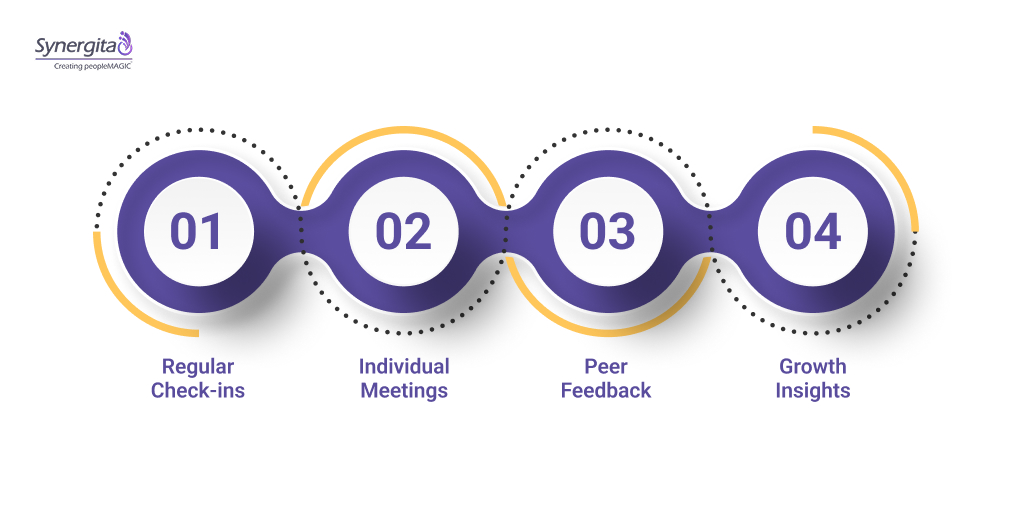Every organization wants its employees to perform at their best, but the real challenge lies in tracking that performance effectively. The question isn’t just “how do you monitor employee performance?” but how you do it in a way that promotes growth, fairness, and motivation.
Modern performance monitoring goes beyond annual appraisals or task completion. With solutions like performance management and OKR software, companies can continuously measure progress, align goals with business outcomes, and enable meaningful conversations between managers and employees.
This blog explores practical methods, tools, and best practices to help you monitor employee performance effectively and create a workplace where every employee can thrive.
Key Takeaways
- A clear, fair performance monitoring system builds trust and accountability across teams.
- Setting measurable goals and tracking progress through OKRs and KPIs helps employees stay aligned with business priorities.
- Continuous feedback and performance evaluation improve engagement and productivity.
- Using a performance management platform like Synergita simplifies tracking, feedback, and growth conversations in one place.
Why Monitoring Employee Performance Matters
When performance isn’t measured, progress becomes guesswork. But effective performance monitoring doesn’t just help managers; it supports employees in understanding expectations, identifying strengths, and growing within their roles.
Tracking employee performance regularly creates a work environment built on transparency and accountability. It ensures that efforts are aligned with team and organizational goals, which drives both individual development and business outcomes.
Here’s why it matters:

- Improved goal alignment: Employees perform better when their objectives are clearly linked to business goals. Monitoring progress through OKRs and KPIs ensures that work stays focused on what truly matters.
- Stronger engagement: Regular feedback helps employees feel seen and supported. When employees receive timely input, not just during reviews, they’re more motivated and connected to their work.
- Data-driven decisions: Monitoring performance with the right tools gives managers insight into patterns and trends. This allows for fairer evaluations and smarter decisions about promotions, support, or skill development.
- Higher productivity and accountability: With clear expectations and progress tracking, employees take ownership of their work. This naturally boosts productivity and encourages a results-oriented culture.
Monitoring isn’t about control; it’s about creating an environment where feedback, clarity, and recognition help people do their best work.
Common Methods for Monitoring Employee Performance

Once the importance of performance monitoring is clear, the next step is applying the right methods. These practical approaches help ensure employees stay aligned, engaged, and consistently moving toward business goals.
1. Set SMART Goals for Clarity
The foundation of effective monitoring is setting clear goals. SMART goals (Specific, Measurable, Achievable, Relevant, and Time-bound) turn broad expectations into actionable outcomes.
Instead of “do better in client calls,” a SMART version could be, “reduce average response time by 30% over the next quarter.” These types of goals eliminate ambiguity and give managers something concrete to track.
2. Track OKRs and KPIs
OKRs (Objectives and Key Results) and KPIs (Key Performance Indicators) provide structured ways to track individual and team performance.
OKRs focus on what needs to be achieved and how progress will be measured. KPIs track key outputs like lead conversion rates, on-time delivery, or customer satisfaction that directly reflect an employee’s impact.
This approach creates transparency around expectations and progress, and it helps teams align better with strategic goals.
3. Use Continuous Feedback
Ongoing feedback helps employees adjust in real time rather than waiting for a formal review cycle. Managers can highlight wins, flag issues early, and support growth all while keeping communication open and timely.,
This also keeps performance conversations more focused on development than evaluation.
4. Enable 360-Degree Feedback
One of the most balanced ways to evaluate performance is by gathering input from peers, subordinates, and even cross-functional collaborators.360-degree feedback uncovers blind spots and highlights behaviors that might not show up in task-based tracking.
When done correctly with structure, anonymity, and relevance, it adds valuable context to overall performance evaluations.
5. Empower Self-Monitoring
Employees who track their own performance tend to stay more engaged and self-aware. Simple tools like personal dashboards, weekly reflections, or progress check-ins help individuals stay connected to their goals.
When employees can see how they’re doing, they’re more likely to take initiative and course-correct when needed. As you implement these methods, the next question becomes when to monitor performance: should it happen continuously, or in scheduled cycles? Let’s explore how to strike the right balance.
Real-Time vs. Periodic Monitoring: Finding the Right Balance
Not all performance monitoring happens the same way or at the same time. Depending on your goals, team structure, and culture, each method has its own value.
A well-rounded strategy usually involves a mix of both.
Comparison: Real-Time, Periodic, and Hybrid Monitoring
| Approach | What It Involves | When to Use It | Key Benefits |
| 1. Real-Time Monitoring | Ongoing feedback, check-ins, and goal progress tracking during day-to-day work | Best for dynamic teams, fast-moving projects, and immediate course corrections | Keeps performance aligned, boosts engagement, and prevents drift |
| 2. Periodic Reviews | Structured reviews (quarterly/bi-annual) covering achievements, challenges, and growth | Ideal for evaluating long-term contributions, planning development goals | Encourages reflection, supports long-term planning, and documents progress |
| 3. Hybrid Approach | Combines real-time feedback with scheduled performance reviews | Suitable for most organizations seeking balanced oversight | Enables both agility and strategic alignment |
Whichever approach you choose, real-time, periodic, or a blend of both, none of it works without clear, timely, and constructive feedback. Let’s explore how to get that part right.
How to Provide Effective Feedback During Performance Monitoring

If you want to monitor employee performance effectively, feedback must be consistent, specific, and growth-oriented, not just tied to annual reviews.
1. Regular Check-ins
Quick, ongoing conversations help keep performance aligned and prevent small issues from becoming bigger problems.
- Schedule short check-ins weekly or bi-weekly to review progress and surface challenges early.
- Focus on actionable next steps rather than generic praise or criticism.
- Use these moments to reinforce priorities and course-correct if needed.
2. One-on-One Conversations
Deeper discussions build trust and provide space for employees to reflect, ask questions, and align on expectations.
- Prepare ahead by reviewing recent performance and feedback trends.
- Keep the focus on goals, progress, and support, not just status updates.
- Use open-ended questions to encourage two-way dialogue and shared ownership.
3. Peer & 360-Degree Feedback
Getting insights from different team members leads to a fuller, more balanced view of performance.
- Structure peer feedback around observable behaviors and recent contributions.
- Keep it anonymous or moderated when necessary to ensure honesty and objectivity.
- Use 360-degree reviews to highlight collaboration skills, communication, and team impact.
4. Use Feedback Insights for Growth
Feedback only drives change when it’s followed by action and integrated into performance development plans.
- Identify recurring themes in feedback and tie them to specific goals or OKRs.
- Use platforms like Synergita to document feedback, track growth areas, and align with performance metrics.
- Revisit insights regularly during check-ins to show progress and maintain momentum.
Feedback is one of the most powerful tools in performance monitoring, but without the right environment, it can fall flat.
Next, let’s address some of the challenges organizations face and how to overcome them.
Overcoming Challenges in Employee Performance Monitoring

Even with the best systems in place, monitoring employee performance comes with its own set of challenges. Addressing these head-on helps create a fair and supportive work environment that builds trust instead of resistance.
1. Bias and Inconsistency
One of the most common challenges in performance monitoring is subjectivity. When evaluations are based more on personal impressions than actual outcomes, it can lead to unfair decisions.
The best way to address this is by setting measurable goals and using standardized KPIs to guide evaluations. A structured approach ensures every employee is assessed on clear expectations rather than vague criteria.
2. Lack of Transparency
If employees don’t know how they’re being evaluated or what’s expected of them, they often feel disconnected and frustrated. Transparent communication around performance metrics, review timelines, and feedback processes helps eliminate confusion.
When employees can see how their work is measured and how it contributes to broader goals, they’re more likely to stay engaged.
3. Feedback Gaps
Feedback delays or inconsistencies often result in missed opportunities for improvement. When feedback is irregular or unclear, employees may continue underperforming without realizing it or feel undervalued despite strong efforts.
Creating a rhythm of regular check-ins and timely conversations ensures that feedback becomes a habit, not an afterthought.
4. Perception of Monitoring as Surveillance
When monitoring feels intrusive, it erodes trust. This often happens when the focus shifts from performance outcomes to activity tracking or surveillance. The goal should always be to support, not control, your team.
By positioning performance monitoring as a growth tool rather than a watchful eye, you build a culture that values accountability and improvement.
With these challenges addressed, monitoring becomes less about oversight and more about support.
Let’s see how your organization can bring all of this together with a system built for growth.
Create a Culture of Performance with the Right Monitoring Approach
So, how do you monitor employee performance in a way that actually improves outcomes, not just measures them? It starts with clarity, continues with consistency, and succeeds with the right tools in place.
Performance monitoring isn’t a one-off review; it’s an ongoing process of setting goals, giving feedback, recognizing progress, and making space for development. When done right, it boosts engagement, builds accountability, and helps teams align with business priorities.
That’s where Synergita comes in.
Synergita’s performance management software simplifies the entire journey, from defining OKRs and KPIs to conducting fair, data-driven reviews and capturing feedback that drives real growth. Whether you’re managing in-office teams or hybrid setups, Synergita equips you to track, evaluate, and support employee performance consistently and confidently.
Frequently Asked Questions
Q1. What metrics matter most when evaluating remote or hybrid employees?
A1. Beyond output, focus on goal completion rates, collaboration indicators, and frequency of feedback loops. These give you context, especially when face time is limited.
Q2. How can I make performance monitoring less time-consuming for managers?
A2. Automate recurring reviews, use performance dashboards to visualize progress, and implement structured templates for feedback. Tools like Synergita simplify these processes.
Q3. Is it okay for employees to set their own performance goals?
A3. Yes, when paired with manager alignment. Co-created goals drive ownership and improve commitment while ensuring strategic direction is maintained.
Q4. What should I do if performance data conflicts with peer feedback?
A4. Dig deeper. Conflicts can reveal blind spots or process gaps. Use both sources to explore patterns, not just outcomes, before making decisions.
Q5. How can I introduce performance monitoring to a team that’s never had it before?
A5. Start with transparency. Explain the ‘why’, involve employees in shaping the process, and roll it out gradually, beginning with feedback, then expanding to metrics and structured reviews.


